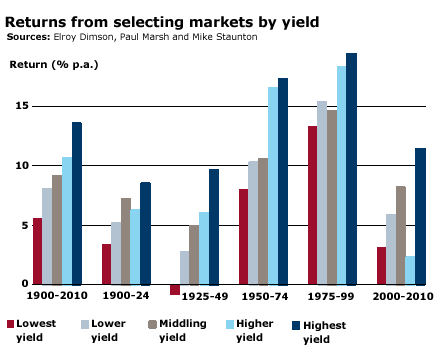| Home | About Us | Resources | Archive | Free Reports | Market Window |
This Strategy Turned $100 into Over $1 MillionBy
Tuesday, March 29, 2011
Which sounds better to you?
The numbers are legit...
Spanning 111 years and 19 countries, this study might be the most comprehensive one done on the topic. Elroy Dimson, Paul Marsh, and Mike Staunton of the London Business School did the study, and it appeared in the 2011 Credit Suisse Global Investment Yearbook.
The topic, surprisingly, is dividend-paying stocks.
Most investors don't pay much attention to dividends. Heck, you can't blame them... What's the point? Week-to-week stock market fluctuations can be greater than the entire year's dividend yield.
But you can't think that way...
The study's authors say, "While year-to-year [stock market] performance is driven by capital gains, long-term returns are heavily influenced by reinvested dividends... The longer the investment horizon, the more important is dividend income."
As the authors remind us, academic studies of dividend yields have already proven that "higher-yielding stocks have outperformed lower yielders." So they wanted to test a different wrinkle: "Perhaps higher-yielding [country stock markets] have also outperformed lower-yielders."
The authors performed a simple test across their 111-year database. The results were astonishing...
Countries where the dividend yields were tiny delivered tiny gains. And countries that paid high dividend yields delivered off-the-charts returns.
The test could hardly have been simpler. Here's how it worked:
The study ranked 19 countries according to their dividend yields at the end of each year. Then it divided the list into five groups, from those with the highest yields on down. (Each group had four countries, except the middle group, which had three countries.)
If you had started with $100 in 1900, and invested in the highest-yielding countries each year, it would have turned into over $1 million at the end of 2010 – versus $370 from investing in the lowest-yielding countries.
The results were uniform across all time frames, as the chart here shows. The highest-yielding countries' stock markets always beat the lowest-yielding countries over time...
 The authors have two conclusions:
1) Investors should focus on the long term and not be too influenced, or daunted, by short-term price fluctuations.
2) Dividends are central to stock valuation.
So what are the top four dividend-yielding countries right now? Spain, Portugal, Australia, and New Zealand.
If you're bold enough, you might consider stepping up and owning country funds in these places... You have 111 years of history on your side.
But whether you invest in these countries or not, keep in mind, over time, dividends end up making up a much larger portion of your total return than you probably ever thought.
Good investing,
Steve
Further Reading:
"Let's say at age 40, you invest $5,000 at 8% and reinvest the income. At age 65 you'll have $34,000," Tom Dyson writes. "If you'd made the same investment at age 20, you'd have $160,000 by the time you turn 65." Learn more about how to turn time to your advantage here: Turn $1,000 of Your Kid's Savings Account into $168,700.
Dividend-growing stocks outperformed non dividend-paying stocks by nearly 250% from 1972 to 2004. Dan Ferris calls them "the only easy money in the stock market." Read more here: Three Easy Steps to an Income-Rich Retirement.
Market NotesU.S. FINANCIALS ARE "BACK ON THE RANGE" Just when you thought the XLF had the $16 level in the rearview mirror, it fakes you out one more time.
Long-time DailyWealth readers know we keep a close eye on the big financial investment fund (XLF). With large weightings in JPMorgan, Goldman Sachs, Wells Fargo, and Bank of America, this fund consists of the "who's who" of American finance. These are the companies that rise and fall with America's ability to earn money, service debts, launch new businesses, and generally just "get along."
From late 2009 to early this year, the XLF was locked in one of longest sideways trading bases you'll ever see. Then last month, it staged an upside breakout to close north of $17 per share... and out of its base. But in just the past few weeks, the XLF suffered a hard selloff... which has returned it to the range.
Even though the XLF has dipped back into this range, it still looks like an asset that "wants" to go higher. It's still enjoying a pattern of "higher highs and higher lows" that began last year. And remember... this fund has the E-Z-Credit power of the U.S. government behind it. But for now, we are "back home on the range" with U.S. financial stocks.
.gif) |
In The Daily Crux
Recent Articles
|

